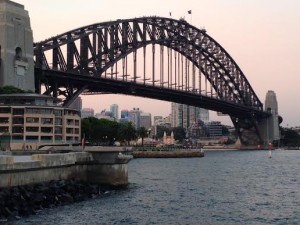
Last month (November 2014) was a very busy moment for World Heritage. At almost the same time, but half way around the globe, ICOMOS held their 18th triennial General Assembly in Florence Italy and IUCN held their once in a decade gathering the World Parks Congress in Sydney Australia.* A few enterprising individuals managed to make an appearance at both meetings, but as is often the case the forces of culture and the forces of nature were far, far apart.
The IUCN World Parks Congress 2014 was a landmark global forum on protected areas. The Congress shared knowledge and innovation and helped set the agenda for protected area conservation for the decade to come. Building on the theme “Parks, People, Planet: Inspiring Solutions,” the gathering presented, discussed and created original approaches for conservation and development and focused on how to address the gap in the world’s conservation and sustainable development agenda.
The ICOMOS 18th General Assembly had as its theme “Heritage and Landscapes as Human Values.” The conference presented a series of scientific symposiums, re-examined earlier foundation documents, such as the International Charter for the Conservation and Restoration of Monuments and Sites (known as the Venice Charter) originally adopted in 1964, and the original 1994 Nara Charter was reconsidered with a new document “Nara + 20: On Heritage Practices, Cultural Value, And The Concept Of Authenticity.”
So what was similar about the two meetings? Well, both were gatherings of experts in the field of culture and nature from around the world with the shared mission of how to best conserve our global heritage. At both meetings, there was recognition of the role of sustainable economic development and of people in any conservation paradigm.

Both had multiple sessions on the importance of traditional knowledge and specifically on traditional ecological knowledge as the basis for balanced and innovative conservation programs. And finally both meetings recognized the central role of landscape as a framework for both cultural and natural resources.
What was different was scale. Over 6,000 attendees, primarily protected area managers, journeyed to Sydney, while the ICOMOS meeting in Florence only drew about 1,000 registrants. Also different was the level of international attention garnered by the two meetings. While the Florence meeting seemed to have good coverage in the Italian press, the World Parks conference garnered an opinion piece on the front page of the editorial section in the Sunday New York Times written by no less a personage than Thomas Friedman. See Stampeding Black Elephants from the November 23, 2014 edition.
Is it any wonder that ICOMOS is very enthusiastic about the joint initiative with IUCN titled Connecting Practices. This has been established with the stated purpose of providing an opportunity for exploring how to form a more genuinely integrated consideration of natural and cultural heritage under the World Heritage Convention – ‘bridging the divide’ that is often observed between nature and culture.
With so many areas of common interest, the effort should be off to a good start.
* A quick primer on the two organizations: IUCN, short for the International Union for the Conservation of Nature, http://www.iucn.org was established in 1948 to create a communication network for environmental conservationists across the globe. ICOMOS, the International Council of Sites and Museums http://www.icomos.org/en/ was founded in 1965 to work for the conservation and protection of cultural heritage places. It is a global non-government organization dedicated to promoting the application of theory, methodology, and scientific techniques to the conservation of the architectural and archaeological heritage.
Both organizations have a responsibility in an advisory role to UNESCO’s World Heritage Committee (secretariat of UNESCO’s World Heritage Convention) for the evaluation and monitoring of World Heritage Sites.


